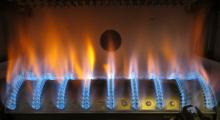Burning wood and other plant matter for heating
What do people mean when they talk about biomass boilers?
‘Biomass’ is any organic matter used as fuel. Biomass boilers typically burn logs, wood pellets or briquettes, although some specialised units can also burn other types of biomass such as miscanthus, a tall perennial grass.
Wood-burning boilers are less common than wood-burning stoves that heat space directly, but the technologies have issues in common, as burning wood impacts forests, the climate, and air quality.
Biomas boiler logistics
Wood boilers can be installed inside or outside a building.
Most wood boilers require fuel to be quite dry because moisture decreases combustion efficiency, increases pollution emissions, and can degrade boiler components over the long run. When harvested, wood has a moisture content of around 50%. Wood pellets are dried down to about 10% moisture content by burning wood or natural gas during the pellet manufacturing process. Domestic and imported firewood logs sold in the UK may be pre-dried in a wood- or gas-fired kiln, but if not pre-dried, logs usually require one to two years storage under cover to allow natural air-drying to take moisture content down to around 20%.
Wood boilers are more high-maintenance than other types of boilers, because unless pellets are automatically fed from storage, they are added manually, and log-fuelled boilers always require manual feeding. Most boilers also require periodic ash removal.
Forest impacts of burning wood
Wood pellets and briquettes made from ground-up trees, and sawdust from wood product manufacturing, as well as wood logs, can be produced in the UK or imported.
Large wood-burning power plants in the UK (such as Drax in Yorkshire) have been criticised for burning wood pellets manufactured by logging native forests of Canada and the United States.
Suppliers of imported pellets and logs for small-scale heating boilers have also been found to sometimes log rare European forests as, for example, was found by an investigation into Romanian wood pellet manufacturing.





